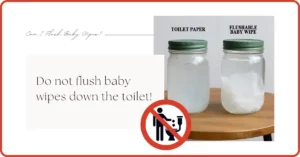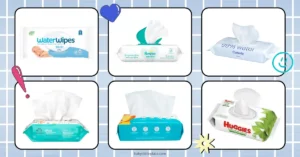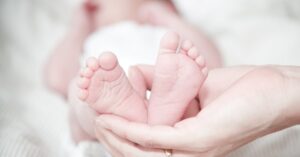Safe sleep for babies includes providing a safe sleeping environment by knowing and understanding the American Academy of Pediatrics’ safe sleeping guidelines. Following the given recommendations reduces the risk of sudden infant death syndrome (also called SIDS) and other sleep-related hazards.

Safe Sleep Tips for Babies
Baby’s Little Place Tips
An essential part of safe sleep for babies is choosing the right place where your baby sleeps, her sleeping position, the kind of crib or bed, type of mattress, and the appropriate home environment (smoke-free zone, right room temperature).
Maybe all the AAP safe sleep guidance seems a little intimidating at first glance, but don’t worry, it is not hard to follow them. You will see that ensuring the baby’s safe sleep actually means keeping it simple! There is no need for all the baby sleeping devices, positioners, bumpers, etc. Basically, all you need is a safe crib, a fitted and firm crib mattress, and a tight-fitting sheet.
Did you know that you affect your baby’s safe sleep already in pregnancy? A healthy lifestyle during pregnancy, which includes a healthy pregnancy diet, alcohol abstinence, and no smoking, reduces the risk of Sudden Infant Death Syndrome (SIDS) and cognitive disorders.
A study supported by the National Institutes of Health had shown that babies born to mothers who both drank and smoked beyond the first trimester of pregnancy have a 12-fold increased risk for SIDS compared to those who were not exposed to the harmful substances.
Avoid smoke exposure, alcohol, and drugs during pregnancy and after birth! Keep a smoke-free zone around your baby to eliminate exposure to secondhand smoke.
Baby safe sleep recommendations
Providing a safe sleeping environment is one of the first and most important parents’ tasks.
The safest sleeping place for the baby:
- in the crib, bassinet, or Pack ‘N Play, which stands next to the parents’ bed and meet all safety standards
- on a firm sleep surface
- without any loose sheets, soft bedding, crib bumpers, or plush toys and pillows in the crib
- on her back, not on a tummy or side
Now let’s look at all the American Academy of Pediatrics’ recommendations a little more closely.
1. Where should a baby sleep?
American Academy of Pediatrics (AAP) recommends a crib, baby bassinet, or Pack ‘N Play as the safest sleeping place for a baby. No matter which one you choose, it must meet all current safety standards set by the U.S. Consumer Product Safety Commission (CPSC).
The CPSC is creating strong product standards for cribs and other nursery products and ensures companies follow all of them. The most notable requirements in their new crib safety standard are the ban of drop-side cribs, stronger crib’s hardware, and the proper slat distance.

Sleeping anywhere other than in a crib, Pack ‘N Play, or bassinet increases the risk of suffocation, strangulation, SIDS, and other sleep-related hazards.
RELATED: A new crib safety standards
2. Babies should sleep on a firm sleep surface!
Do not let your baby sleep on soft surfaces, such as sofas, armchairs, bean bag chair, or infant pillow. The baby should also not sleep unsupervised on sitting devices, incline sleepers, rockers, or gliders!
- Choose a firm and tight-fitting mattress for a crib!
- Use only the mattress that came with a bassinet or Pack ‘N Play! For instance, a baby can entrap between a thicker mattress and the soft side of a Pack ‘N Play, which may lead to suffocation.
Firm crib mattress
A firm crib mattress is especially important for newborns and young babies.
Infants can not roll over consciously! However, if they manage to roll to the tummy, their face could sink into a soft sleeping surface, which may lead to suffocation.
Later on, when they start to push and stand up, a firm crib mattress offers them enough resistance to do so. As such, a firm crib mattress contributes to better bone and muscle development as well!
Many cribs convert into a toddler bed and daybed, where you can use the same crib mattress, so you might worry that such a crib mattress would be too firm for a toddler.
Well, toddlers tend to sleep well on a firm surface. But if a toddler cuddles on your bed a lot, he might get used to a softer sleeping surface. You can solve this problem by deciding on a dual-sided crib mattress.
Snuggle fit
Another important feature is a snuggle fit! You have to choose a crib mattress that fits snuggly into your crib!
Having a full-size baby crib makes your job easier. The size of full-size cribs and mattresses is regulated by the government, which enables that any standard size crib mattress fits into any crib.
On the contrary, the size of the mini cribs is not defined by the law. As a result, the interior dimensions of mini cribs can vary a lot. Most mini cribs have internal measurements (38 inches long by 24 inches wide) that correspond to most mini crib mattresses on the market. However, be more careful when buying a mini crib mattress.
RELATED: Crib Mattress Buying Guide
3. Where should a crib, bassinet, or Pack ‘N Play be placed?
The safest sleeping place for a baby is next to her mother, but not in the same bed! Room-sharing, without bed-sharing, is the best co-sleeping option!
The crib, bassinet, or a Pack ‘N Play should be placed in the parent’s bedroom for at least 6 months, even better the whole first year. This arrangement may decrease the risk of SIDS by as much as 50%!
Whether you decide on a shared room or nursery, keep the crib away from blinds and windows or anything else that an older baby can pull down. Blinds or curtain cords on a baby rich increase the risk of strangulation.
4. The safest sleeping position for the baby
No matter if it is naptime or bedtime, always put your baby to sleep on her back until she turns one year of age!
Do not place the baby to sleep on her tummy!
Sleeping on the tummy puts babies at risk for suffocation, especially if the sleeping surface is not firm enough. Such sleeping also increases the risk of overheating and the chance of SIDS.
Some parents think that sleeping on the back increases the risk of choking by vomit or spiting. But research has shown they are at lower risk than those who sleep on their stomachs. When lying on their backs, their upper airway is above the esophagus. Vomiting milk that rises up the esophagus is easily swallowed again – instead of entering the respiratory tract.
But, when the baby sleeps on her stomach, the esophagus is above the upper airway. If a baby spits out milk, it can enter the airways and lungs.
Do not place the baby to sleep on her side!
Sleeping on the side is also considered less safe, and it is not advised. Babies easily roll over to their tummy from their side, but they do not have the strength to turn back.
Other recommendations
… for creating a safe sleeping environment.
1. Make sure the baby does not overheat!
That includes:
- A proper room temperature, which is not too hot or too cold (68 to 72 degrees Fahrenheit is considered the best)
- Use a breathable crib mattress and sheets made of natural materials.
- Do not dress the baby too warmly. Dress her in light sleep clothes.
- Baby needs only one layer more than an adult would wear to be comfortable.
- Never cover the baby’s head!
2. Things that should NEVER find the place in a crib:
Keep soft objects and loose bedding away from the infant’s crib!
Soft objects increase the risk of SIDS, suffocation, entrapment, and strangulation! A large percentage of infants who died of SIDS have been found with face pressed against a soft object or head covered by bedding.
You should never put pillows, blankets, and sheepskins in a baby’s sleep environment. If you think she is too cold, use a sleep sack or a swaddle. But keep in mind that you should use the right swaddling technique and stop by the time she is trying to roll over!
Do not put plush toys, comforters, and position devices in the crib either.
Avoid crib bumper pads!
If you decide to use a crib bumper anyway, use a thin bumper made of breathable materials. It shouldn’t have any loose parts or strings and must fit firmly around the crib.
3. Consider offering a pacifier when placing the infant for sleep.
Wait with the pacifier until the breastfeeding is fully established (3 to 4 weeks). Also, do not force it if your baby doesn’t want it.
Use only the pacifier! Do not hang it around the baby’s neck or attach it to baby clothes, stuffed toys, or other objects.
Pacifiers may decrease the risk of SIDS, even if it falls out of the baby’s mouth. If a pacifier falls out of the baby’s mouth, it does not need to be reinstalled.
4. Breastfeeding is recommended!
Amongst other beneficial effects, breastfeeding is also associated with a lower risk of SIDS. American Academy of Pediatrics recommends exclusive breastfeeding for the first 6 months of a baby’s life.



